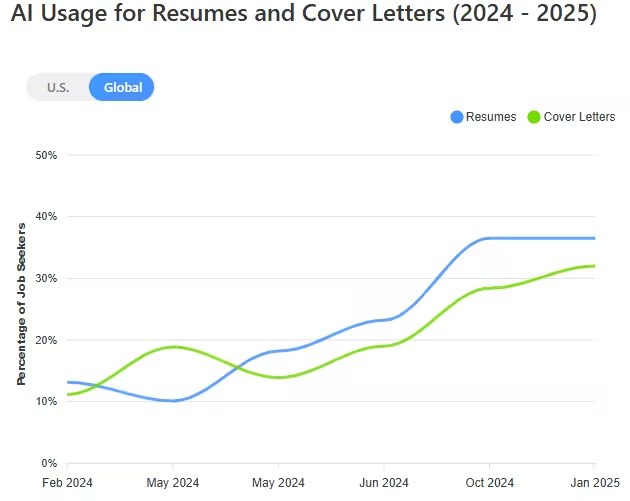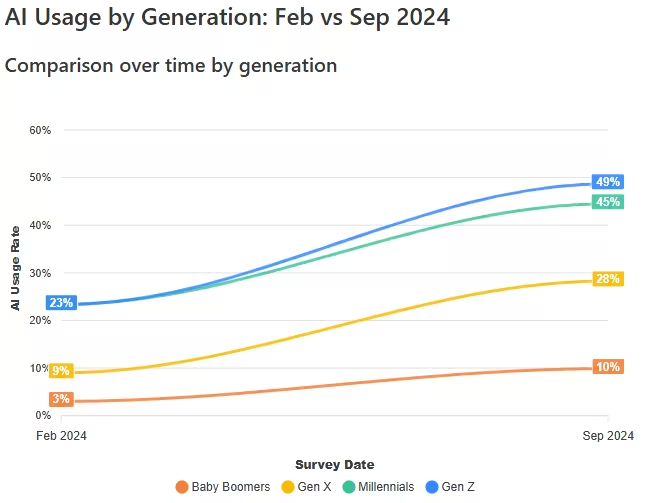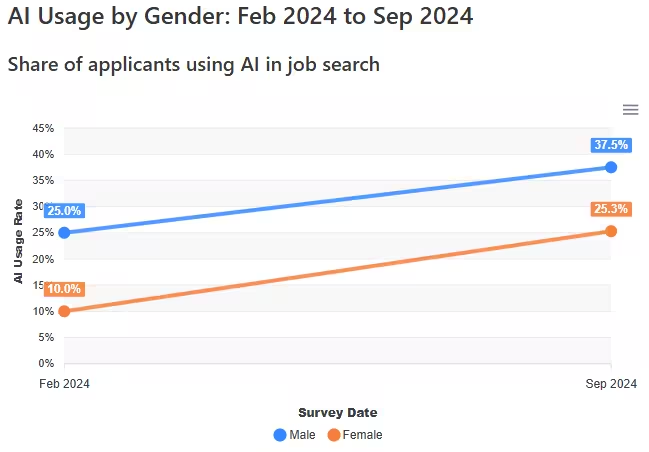Many of our competitors use AI to mass-post blogs for promotional purposes. The irony. We believe that humanity must be preserved, so all of this text is strictly human-written.
We researched job applicant AI usage and gathered our results to the info page. This blog post goes through the findings and explains what they mean and why they matter.
AI usage trends among job seekers
Ever since the even somewhat usable ChatGPT models were released back in 2022, job searching has slowly been getting more competitive. Using AI to write job applications used to be niche, but now it is slowly but surely growing close to being mainstream.
Our findings state that in early 2024, around 12% of job seekers utilized AI to write resumes or cover letters. This has been slowly increasing, passing the 20% mark in June 2024 and reaching 30% in late 2024 to early 2025. We expect this to stabilize in the younger generations, and the older generations to slowly catch up year after year.
The references can be found at the bottom of the article, and they are also listed in a detailed manner in our statistics info page.

What about generation-based usage statistics? We found out that in early 2024, Gen Z and Millennials were tied at 23% AI usage in job seeking. Gen X came third at 9%, and Baby Boomers had a recorded AI usage at 3%. In September 2024 these numbers had increased for every generation. Gen Z's AI usage in job search grew to 49%, and Millennials reached 45%. Gen X showed a growth of more than 100%, all the way to 20%. The AI usage among Boomers increased to 10%.
As older workers continue to retire, they will be replaced by younger generations. The young job seekers are more likely to use AI, so it is clear to project that AI usage will be prevalent in the global job markets.

Our gender-related findings come from the February and September 2024 data. In February, 25% of men and 10% of women reported using AI in job search. Those numbers were measured at 37.5% for men and 25.3% for women in the later September study. The growth has been impressive.

How are job seekers utilizing AI?
The share of job seekers using AI for the following tasks in June 2024 was:
- Resume building 23%
- Cover letters 19%
- Interview preparation 18%
- Test assignments 17%
A fun fact we found was that 23% of applicants using AI don't edit their cover letters at all.
AI usage for interview prep has been rising from around 12% in early to mid-2024, all the way to 27% in October 2024 (U.S.).
We also noticed increasing popularity for AI usage for skills tests and assignments. The share of job seekers utilizing AI for these tasks was 5-10% in early 2024, and climbed to 16.8% in June 2024.
How to stop the heavy AI users from dominating the hiring process
In the current year, detecting AI usage is gaining importance like never before. It is not only required in schools and classrooms, but also in the real world. It is true that an applicant who used AI in every step of the job search is more efficient (41% more applications sent out) but also can overshadow the "legit" applicants as well. CoverSentry doesn't exactly see that kind of world as a utopic paradise.
CoverSentry provides AI detection models for job seekers and HR teams to stay on top of the AI wave that seems to be washing over the job markets as we speak.
In hiring processes, the tasks should be adjusted to be less mechanical and more personal. It takes real effort to build AI-proof steps to filter out applications in a fair and just way. The trickiness of it all is why we think this kind of overhaul isn't happening any time soon. All we (and HR) can do is to detect the users who utilized AI and decide in-house what to do with them.
Is it bad to use AI? Not really. Every company has their own policies to decide how to handle AI applications. If you use our AI writing agent, we automatically pass all generated job applications through our proprietary detection model to see how AI-like the produced text was.
Data selection
We selected studies and surveys that showed very little bias. A lot of the surveys were funded by companies who provide software for job seekers or hiring teams. Thus, many purposefully or semi-accidentally skewed the results to place their product into a better light. It was essential for CoverSentry to discard skewed surveys. The number of subjects in the surveys ranges from 1000 to around 3000 per study.
CoverSentry actively searches for more studies in the field and will add more data points over time. We feel that it is our responsibility to display this information in an unbiased and clear way.
Conclusions
As AI and chatbots became more widely used, real use cases such as job seeking saw an increase in usage in 2024 and 2025. The trend for AI-written resumes and cover letters was strong, rising from 12% to over 30% globally.
We also saw an increase in every generation, generally 200-300% from February 2024 to September 2024. Use cases that were more niche such as interview preparation are becoming mainstream. For now, the two dominating use cases are resumes and cover letters. CoverSentry expects the young generations to utilize AI in almost every step of the job search process. This can skew the competition in an unhealthy way, where some job hunters might feel like they cannot compete without AI.
All the statistics and graphs are displayed on our info page.
Check If Your Cover Letter Looks AI-Generated
Use our free AI detection tool to see if your cover letter might get flagged by recruiters.
Check Your Cover Letter NowReferences
- ResumeBuilder U.S. Survey (Feb 2024, n=1,000)
- CharityJob UK Report (May 2024, n=2,309)
- ResumeTemplates Gen Z Study (May 2024, n=2,921)
- Capterra Global Study (Jun 2024, n=2,997)
- JobLeads U.S. Research (Sep 2024, n=1,028) [1]
- ResumeTemplates U.S. Workplace Study (Oct 2024, n=1,258)
- MyPerfectResume Cover Letter Trends Report (Jan 2025, n=1,000)